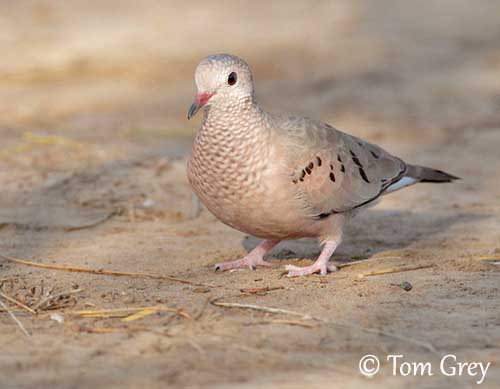
Fr : Colombe à queue noire
Ang : Common Ground-Dove
All : Sperlingstäubchen
Esp : Columbina Común – Rolita (Porto Rico)
Ita : Tortora passerina
Nd : Musduif
Sd : Nordlig markduva
Port : Rolinha-cinzenta
Photographers:
Roger Ahlman
Pbase Galleries Peru and Ecuador
Alfredo Colón
Puerto Rico Wildlife
Tom Grey
Tom Grey's Bird Pictures
Jean-Claude Jamoulle
A la rencontre des Oiseaux
Tom Merigan
Tom Merigan’s Photo Galleries
Text by Nicole Bouglouan
Sources:
HANDBOOK OF THE BIRDS OF THE WORLD vol 4 by Josep del Hoyo-Andrew Elliott-Jordi Sargatal - Lynx Edicions - ISBN: 8487334229
PIGEONS AND DOVES by David Gibbs, Eustace Barnes and John Cox - Pica Press Sussex - ISBN: 1873403607
A GUIDE TO THE BIRDS OF MEXICO AND NORTHERN CENTRAL AMERICA by Steve N. G. Howell, Sophie Webb - Oxford University Press - ISBN: 0198540124
A GUIDE TO THE BIRDS OF COLOMBIA by Steven L. Hilty and William L. Brown - Princeton University Press – ISBN 069108372X
BirdLife International (BirdLife International)
All About Birds (Cornell Lab of Ornithology)
What Bird-The ultimate Bird Guide (Mitchell Waite)
Wikipedia, the free encyclopaedia
Common Ground-Dove
Columbina passerina
Columbiformes Order – Columbidae Family
INTRODUCTION:
The genus Columbina includes nine small ground-doves. These New World’s Columbidae are usually found in open habitat in pairs or in small flocks. They show a rufous wing panel in flight, and females have duller appearance than males. The Common Ground-Dove has a wide range and 19 subspecies share the distribution. They are the smallest of all doves.
DESCRIPTION OF THE BIRD:
Biometrics:
Length: 16-18 cm
Weight: M: 24-37 g – F: 22-50 g
The adult male of nominate race has grey to pinkish-grey crown, nape, hindneck and upper mantle, all slightly scaled brown. The forehead is pinkish-brown.
The upperparts, including lower mantle, scapulars, back and rump are greyish-brown. On the upperwing, tertials, inner secondaries and inner greater and median wing-coverts are greyish-brow too. The primary flight feathers are chestnut to rufous with blackish tips and outer webs. We can see several iridescent purplish-black or dark blue spots on the wings.
The uppertail-coverts and the inner two pairs of rectrices are greyish-brown, whereas the outer rectrices are black with white tips.

Nominate race "passerina"
Male - Texas
On the underparts, chin and throat are whitish with faint scaling. Face, neck sides and breast are pale pink with distinct scaled appearance. Lower breast and belly are pinkish-brown, whereas flanks, lower belly and undertail-coverts are greyish-brown. Axillaries and underwing coverts are reddish-brown.
The bill is black with red, orange, yellow or pink at base, and black tip. The eyes are variably red-brown to reddish-orange, surrounded by blue-grey orbital skin. Legs and feet are pink.
The female is duller and has less grey on head. The spots of the upperwing are mostly purplish-brown or dull chestnut.
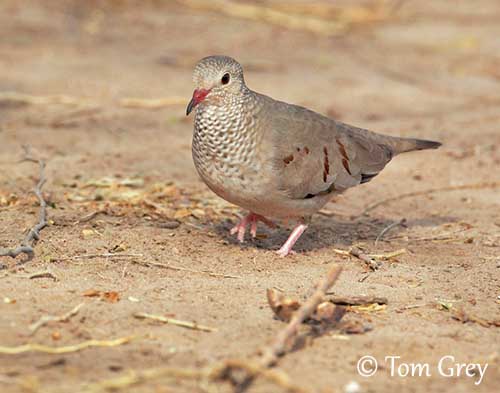
Nominate race "passerina"
Female - Texas
The juvenile resembles female but much duller. The feathers are edged pale buff and the breast shows dusky markings. The young male has some pink on the neck.
SUBSPECIES AND RANGE:
The Common Ground-Dove has 19 recognized subspecies which differ in bill colour and shades of brown, as well as white areas on the tail.
The Common Ground-Dove is found from southern United States, parts of Central America, the Caribbean, northern and north-eastern South America.
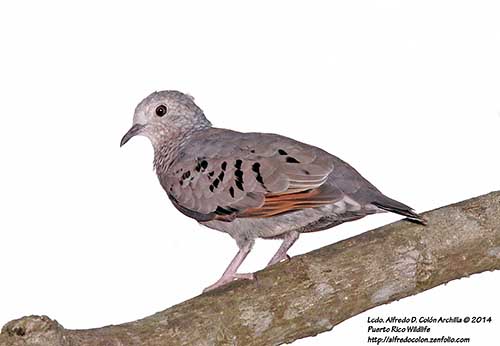
Race "portoricensis"
Puerrto Rico
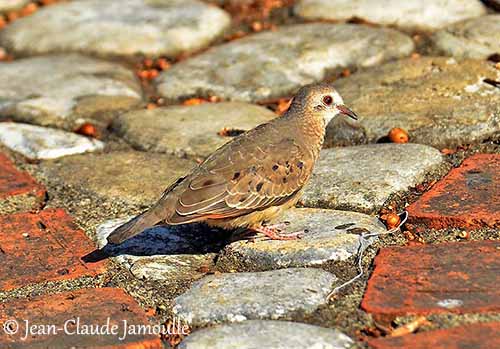
Race "umbrina"
Dominican Republic
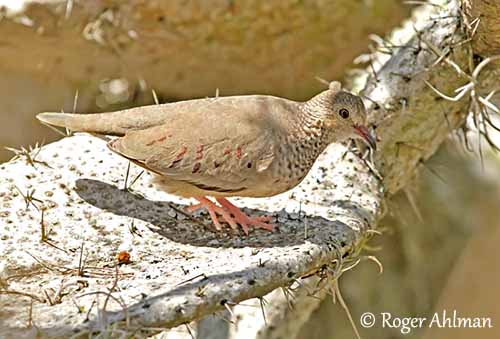
Race "quitensis"
Ecuador
HABITAT:
The Common Ground-Dove frequents open habitat, cultivated areas, savanna, pastures, woodland edges, villages and towns where it can be commonly seen in lawns. They roost in trees.
According to the range, this species can be seen from sea-level up to 2500 metres of elevation in Central America, and up to 2900 metres in Central Valley of Ecuador.

Race "quitensis"
Ecuador
CALLS AND SONGS: SOUNDS BY XENO-CANTO
The Common Ground-Dove gives soft, monotonously repeated “coo-ah” with rising inflection, given in a long series at a rate of 0,8 – 1,2 note/second.
BEHAVIOUR IN THE WILD:
The Common Ground-Dove feeds primarily on seeds, especially those of grasses and weeds. It also takes small fruits and berries, and waste grain in cultivated areas. It may feed on some insects, grubs and caterpillars.
It spends much time feeding on the ground, walking about while pecking up seeds. They can be seen foraging in pairs or small flocks. If they are disturbed, they readily flush, flying rapidly to reach the dense cover.
Nominate race "passerina"
Texas
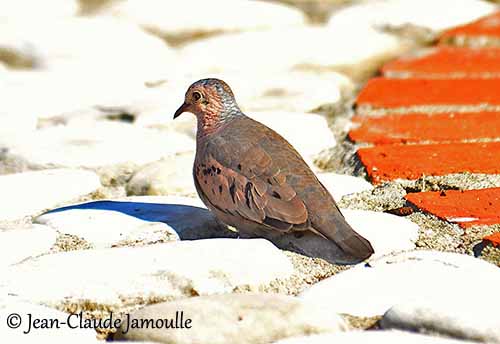
Race "umbrina"
Dominican Republic
During the breeding season, the male performs courtship displays. It struts with stiff steps and the breast feathers are puffed out. The male bows while cooing in front of the female, bobbing the head and flicking its wings.
Once the pair is formed, both mates often perch close to each other and perform mutual preening.
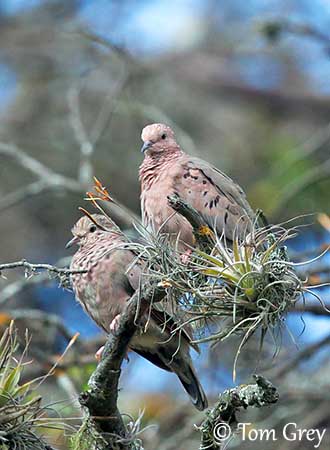
Race "quitensis"
Ecuador
Female left - Male right
The Common Ground-Dove is usually resident, although the North American populations may move S in winter, while other races wander irregularly N to Oregon and New York.
The bird in flight produces a whirring sound. This species is a fast flier and performs rapid wingbeats.
REPRODUCTION OF THIS SPECIES:
The breeding season varies depending on the range, but also according to the food resources. Throughout the wide range, the Common Ground-Dove breeds almost all year round.
The nest is usually placed on the ground protected by grass tussock or in dense low shrub, but occasionally, it is built in tree, as high as 9 metres above the ground.
The nest is a shallow, flimsy platform made with grasses and stems, and lined with fine roots and grasses.
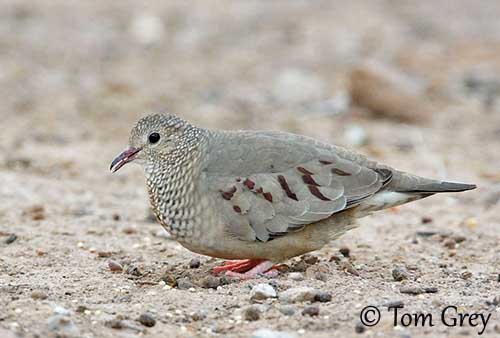
Race "pallescens"
Female - California
The female lays 1-3, often 2 white eggs. The incubation is shared by both adults and lasts 13-14 days. The chicks are fed by both parents. They are covered with sparse grey down. They are altricial and may fly about 11-12 days after hatching. They may start breeding at 80 days old.
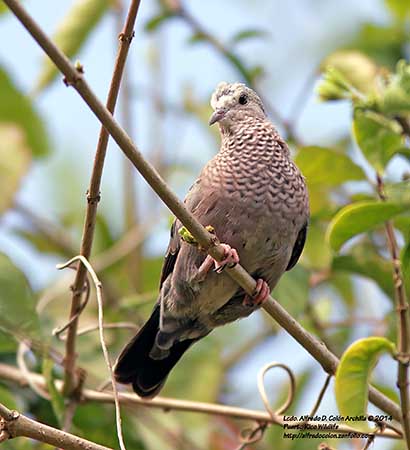
Race "portoricensis"
Puerrto Rico
PROTECTION / THREATS / STATUS:
The Common Ground-Dove is relatively common depending on the range. This species seems to be adaptable to modified habitats and can be seen in urban areas.
Populations show a small decrease in North America, but the global population size is extremely large and currently, the Common Ground-Dove is evaluated as Least Concern.
Nominate race "passerina"
Texas